The post is part 5 of our series on what separates thriving dental practices from the rest. If you missed any previous part of this series, you can access it here.

Best Practice #5: Create and Manage to a Structured Collection Process
It just makes sense that accounts receivable management be treated as a key priority if you desire to run a successful dental practice. But let’s face it, it’s not easy. Complexity abounds and many practices struggle to efficiently support both self-pay patients and insurance companies that aren’t always prompt with their reimbursement payments! For this reason, establishing and monitoring your collection process is of critical importance.
A solid collection process starts with a well-defined credit policy. This policy clearly and concisely educates your staff on the policy specifics and what processes must be followed and when. For example, the document should define payment timing for both insurance and self-pay patients, define “past due,” and specifically outline your collections process (the type and frequency of notices, escalation process for non-payers, etc.)
We advise our clients to clearly separate the financial arrangements from patient care. Staff dedicated to billing and collections are more equipped to address patient’s financial concerns, and it prevents your dental practitioners from getting “pulled away” from their core responsibilities.
In fact, dental practices who have the most effective collections processes put an emphasis on their front-desk staff. Your front-desk staff should be thoroughly trained to accept payments and verify insurance coverage prior to any services. If a balance exists, they should be knowledgeable and helpful in explaining the payment options to patients, while at the same time setting clear expectations that any balances should be paid according to your practice’s standard timeline.
Understand that discussing financial matters (especially overdue bills) with patients can often be awkward for your staff. This is particularly true for newer staff members. Be sure to provide them with specific scripts that can be used to guide their interactions and provide feedback and coaching until they develop the confidence needed to handle these discussions competently and professionally. While it may take a little effort, it’s well worth the time for the financial health of you practice.
We hope this was helpful!
If you’re looking to increase both the revenues and profitability of your dental practice, don’t hesitate to reach out at 844-424-9637.
If you’d like to receive the full series with all seven best practices in one whitepaper, just complete the short form below.
LET US KNOW WHERE WE SHOULD WE SEND YOUR FREE GUIDE!
7 Key Financial Practices That Separate Thriving, Growing Practices From The Rest.

There’s no denying it. Creating a thriving practice is about much more than practicing medicine!
Topping the list of “other” priorities is your practice’s financial management. In this short guide, the experts at STAC Bizness Solutions outline 7 financial best practices that differentiate struggling practices from those which are highly profitable and experiencing healthy levels of growth.

